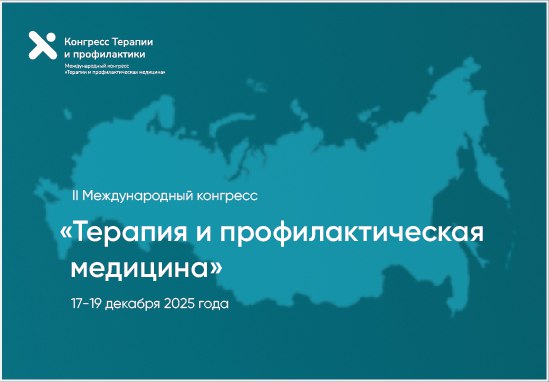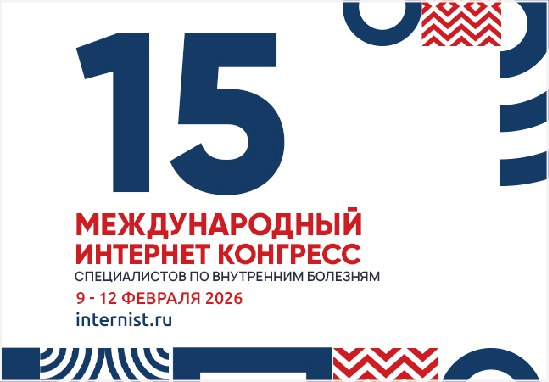Профилактика сердечно-сосудистых заболеваний на протяжении жизни. Часть II: детский и подростковый периоды
https://doi.org/10.15829/1728-8800-2021-2896
Аннотация
В последние годы исследователи всё чаще отмечают, что на развитие и здоровье сердечно-сосудистой системы влияют как традиционные факторы риска (ФР), так и другие детерминанты, входящие в состав экспосома человека — совокупности факторов внешней и внутренней среды, влияющих на генетику и эпигенетику, в результате чего, в конечном итоге, формируется тот или иной (более или менее здоровый) фенотип. Компоненты экспосома оказывают непрерывное воздействие на протяжении всех периодов жизни человека. Многие ФР обладают накопительным эффектом, в связи с чем профилактику сердечно-сосудистых заболеваний (ССЗ) важно начинать как можно в более раннем возрасте. Целью обзора является рассмотрение различных аспектов профилактики ССЗ в детском и подростковом периодах. Данные периоды являются критически важными для формирования большинства поведенческих привычек, которые в дальнейшем сохраняются на протяжении жизни. Первостепенную роль в приобщении детей и подростков к ведению здорового образа жизни играет позитивный пример родителей и ближайшего окружения. Целенаправленные программы в детских садах и школах, посвященные повышению грамотности в вопросах здоровья, раннее выявление и своевременная коррекция классических и неклассических ФР ССЗ, диагностика генетически обусловленных заболеваний с преимущественным поражением сердца и сосудов, профилактика внезапной сердечной смерти при наличии повышенного риска ее развития также являются важными методами профилактики ССЗ в детском и подростковом периодах. Большое значение имеют меры популяционной профилактики, включающие контроль за рекламой и информацией в медиа-ресурсах, законодательные запреты продажи алкоголя, никотин-содержащих продуктов, формирование инфраструктуры для ведения здорового образа жизни.
Об авторах
О. В. КопыловаРоссия
Оксана Викторовна Копылова — научный сотрудник лаборатории клиномики.
Москва
А. И. Ершова
Россия
Александра Игоревна Ершова — кандидат медицинских наук, руководитель лаборатории клиномики.
Москва, Тел.: +7 (926) 178-63-58
А. Н. Мешков
Россия
Алексей Николаевич Мешков — кандидат медицинских наук, руководитель лаборатории молекулярной генетики.
Москва
А. В. Концевая
Россия
Анна Васильевна Концевая — доктор медицинских наук, заместитель директора по научной и аналитической работе.
Москва
О. М. Драпкина
Россия
Оксана Михайловна Драпкина — доктор медицинских наук, профессор, член-корр. РАН, директор, руководитель отдела фундаментальных и прикладных аспектов ожирения.
Москва
Список литературы
1. Daiber A, Lelieveld J, Steven S, et al. The “exposome” concept-how environmental risk factors influence cardiovascular health. Acta Biochim Pol. 2019;66(3):269-83. doi:10.18388/abp.2019_2853.
2. Mendis S, Puska P, Norrving B, Editors. Global Atlas on Cardiovascular Disease Prevention and Control. Geneva: World Health Organization. 2013. 155 p. ISBN: 9789241564373.
3. Копылова О . В ., Ершова А. И., Мешков А. Н., Драпкина О. М. Профилактика сердечно-сосудистых заболеваний на протяжении жиз-ни. Часть 1: преконцепционный, пренатальный и грудной периоды. Кардиоваскулярная терапия и профилактика. 2020;19(6):2647. doi:10.15829/1728-8800-2020-2647.
4. Dendale P, Scherrenberg M, Sivakova O, Frederix I. Prevention: From the cradle to the grave and beyond. Eur J Prev Cardiol. 2019;26(5):507-11. doi:10.1177/2047487318821772.
5. Abrignani MG, Lucà F, Favilli S, et al. Lifestyles and Cardiovascular Prevention in Childhood and Adolescence. Pediatr Cardiol. 2019;40(6):1113-25. doi:10.1007/s00246-019-02152-w.
6. Александров А. А., Бубнова М. Г., Кисляк О. А. и др. Рекомендации по профилактике сердечно-сосудистых заболеваний в детском и подростковом возрасте. Российский кардиологический журнал. 2012;(6s1):4-39.
7. Boberska M, Horodyska K, Kruk M, et al. Parental strategies restricting screen use among children, screen home environment, and child screen use as predictors of child body fat: A prospective parent–child study. Br J Health Psychol. 2019;24(2):298-314. doi:10.1111/bjhp.12354.
8. Ежов М . В ., Бажан С . С ., Ершова А . И . и др. Клинические рекомендации по семейной гиперхолестерине-мии. Атеросклероз. 2019;15(1):58-98.
9. Raghuveer G, White DA, Hayman LL, et al. Cardiovascular Consequences of Childhood Secondhand Tobacco Smoke Exposure: Prevailing Evidence, Burden, and Racial and Socioeconomic Disparities: A Scientific Statement from the American Heart Association. Circulation. 2016;134(16):e336-59. doi:10.1161/CIR.0000000000000443.
10. Stansfeld S, Clark C. Health Effects of Noise Exposure in Children. Curr Environ Heal reports. 2015;2(2):171-8. doi:10.1007/s40572-015-0044-1.
11. Morgan PJ, Collins CE, Plotnikoff RC, et al. The “Healthy Dads, Healthy Kids” community randomized controlled trial: A community-based healthy lifestyle program for fathers and their children. Prev Med (Baltim). 2014;61:90-9. doi:10.1016/j.ypmed.2013.12.019.
12. Fatima Y, Doi SAR, Mamun AA. Longitudinal impact of sleep on overweight and obesity in children and adolescents: A systematic review and bias-adjusted meta-analysis. Obes Rev. 2015;16(2):137-49. doi:10.1111/obr.12245.
13. Whitebread D, Bingham S. Habit Formation and Learning in Young Children. https://mascdn.azureedge.net/cms/the-money-advice-service-habit-formation-and-learning-in-young-children-may2013.pdf (25 March 2021).
14. Childhood Obesity Surveillance Initiative. https://www.euro.who.int/__data/assets/pdf_file/0019/400654/COSI-Severe-Obesity-FS-ENG-LowRes.pdf (25 March 2021).
15. Juonala M, Magnussen G, Berenson GS, et al. Childhood Adiposity, Adult Adiposity, and Cardiovascular Risk Factors. N Engl J Med. 2011;365(20):1876-85. doi:10.1056/NEJMoa1010112.
16. Khera AV, Chaffin M, Wade KH, et al. Polygenic Prediction of Weight and Obesity Trajectories from Birth to Adulthood. Cell. 2019;177(3):587-596.e9. doi:10.1016/j.cell.2019.03.028.
17. Shabana, Hasnain S. Obesity, More than a ‘Cosmetic’ Problem. Current Knowledge and Future Prospects of Human Obesity Genetics. Biochem Genet. 2016;54(1):1-28. doi:10.1007/s10528-015-9700-2.
18. Nittari G, Scuri S, Petrelli F, et al. Fighting obesity in children from European World Health Organization member states. Epidemiological data, medical-social aspects, and prevention programs. Clin Ter. 2019;170(3):223-30. doi:10.7417/CT.2019. 2137.
19. Health Behaviour in School-aged Children (HBSC) data source — European Health Information Gateway. https://gateway.euro.who. int/en/datasets/hbsc/. (25 March 2021).
20. Hoey H. Management of obesity in children differs from that of adults. In: Proceedings of the Nutrition Society. Cambridge University Press. 2014;73:519-25. doi:10.1017/S0029665114000652.
21. Villegas-Navas V, Montero-Simo MJ, Araque-Padilla RA. The effects of foods embedded in entertainment media on children’s food choices and food intake: A systematic review and meta-analyses. Nutrients. 2020;12(4):964. doi:10.3390/nu12040964.
22. Kontsevaya AV, Imaeva AE, Balanova YA, et al. The extent and nature of television food advertising to children and adolescents in the Russian Federation. Public Health Nutr. 2020;23(11):1868-76. doi:10.1017/S1368980020000191.
23. Lagomarsino M, Suzanne Suggs L. Choosing imagery in advertising healthy food to children: Are cartoons the most effective visual strategy? J Advert Res. 2018;58(4):487-98. doi:10.2501/JAR-2018-003.
24. García AL, Morillo-Santander G, Parrett A, Mutoro AN. Confused health and nutrition claims in food marketing to children could adversely affect food choice and increase risk of obesity. Arch Dis Child. 2019;104(6):541-6. doi:10.1136/archdischild-2018-315870.
25. Приказ Минздрава России от 15.01.2020 N 8 “Об утверждении Стратегии формирования здорового образа жизни населе-ния, профилактики и контроля неинфекционных заболеваний на период до 2025 года”. http://www.consultant.ru/document/cons_doc_LAW_344362/. (25 March 2021).
26. Murugesan S, Nirmalkar K, Hoyo-Vadillo C, et al. Gut micro- biome production of short-chain fatty acids and obesity in children. Eur J Clin Microbiol Infect Dis. 2018;37(4):621-5. doi:10.1007/s10096-017-3143-0.
27. Groselj U, Kovac J, Sustar U, et al. Universal screening for familial hypercholesterolemia in children: The Slovenian model and literature review. Atherosclerosis. 2018;277:383-91. doi:10.1016/j.atherosclerosis.2018.06.858.
28. Mikkelsen BE. Policies to promote on physical activity and healthy eating in kindergartens from theory to practice. Int J Pediatr Obes. 2011;6(Suppl. 2):8-11. doi:10.3109/17477166.2011.613653.
29. Centers for Disease Control and Prevention (CDC). School health guidelines to promote healthy eating and physical activity. MMWR Recomm reports Morb Mortal Wkly report Recomm reports. 2011;60(RR-5):1-76. http://www.ncbi.nlm.nih.gov/pubmed/21918496. (25 March 2021).
30. Heelan KA, Bartee RT, Nihiser A, Sherry B. Healthier school environment leads to decreases in childhood obesity: The Kearney Nebraska story. Child Obes. 2015;11(5):600-7. doi:10.1089/chi.2015.0005.
31. Приложение N 1. Перечень исследований при проведении профилактических медицинских осмотров несовершеннолетних. https://base.garant.ru/71748018/10ed0f917186039eb157d3ba4f962ee5/#block_11000. (28 March 2021).
32. Kalia SS, Adelman K, Bale SJ, et al. Recommendations for reporting of secondary findings in clinical exome and genome sequencing, 2016 update (ACMG SF v2.0): A policy statement of the American College of Medical Genetics and Genomics. Genet Med. 2017;19(2):249-55. doi:10.1038/gim.2016.190.
33. Meshkov A, Ershova A, Kiseleva A, et al. The LDLR, APOB, and PCSK9 variants of index patients with familial hypercholesterolemia in Russia. Genes (Basel). 2021;12(1):1-17. doi:10.3390/genes12010066.
34. Ревазян К . З ., Мешков А . Н ., Ершова А.И . и др. Психосоциальные, этические, правовые и экономические аспекты генетического скрининга на но-сительство вариантов, вызывающих развитие моногенных рецессивных заболеваний. Профилактическая медицина. 2021;24(2):102-8. doi:10.17116/profmed202124021102.
35. Müller-Riemenschneider F, Nocon M, Willich SN. Prevalence of modifiable cardiovascular risk factors in German adolescents. Eur J Cardiovasc Prev Rehabil. 2010;17(2):204-10. doi:10.1097/HJR.0b013e328334703d.
36. Münzel T, Hahad O, Kuntic M, et al. Effects of tobacco cigarettes, e-cigarettes, and waterpipe smoking on endothelial function and clinical outcomes. Eur Heart J. 2020;41(41):4057-70. doi:10.1093/eurheartj/ehaa460.
37. Kalkhoran S, Benowitz NL, Rigotti NA. Prevention and Treatment of Tobacco Use: JACC Health Promotion Series. J Am Coll Cardiol. 2018;72(9):1030-45. doi:10.1016/j.jacc.2018.06.036.
38. Александров А.А ., Розанов В.Б ., Котова М.Б . и др. Раннее начало курения и изменения показателей ожирения, уровня артериального давления и липидного спектра крови у лиц мужского пола: результаты 26-летнего проспективного исследования. Кардиоваскулярная терапия и профилактика. 2020;19(5):2610. doi:10.15829/1728-8800-2020-2610.
39. Вредные привычки и их последствия. Вред алкоголя и табакокурения. Влияние вредных привычек на организм — Здоровая Россия. https://www.takzdorovo.ru/privychki/. (25 March 2021).
40. Yousuf H, Narula J, Zwetsloot PP, et al. Using entertainment to improve lifestyles and health. Lancet. 2019;394(10193):119-20. doi:10.1016/S0140-6736(19)30250-8.
41. Kopylova OV, Rakovskaya YS, Yakunchikova MS, Savchuk PO. Medical Volunteers and their role in CVD prevention. Eur Heart J. 2020;42(11):1057-9. doi:10.1093/eurheartj/ehaa1013.
42. Bafunno D, Catino A, Lamorgese V, et al. Tobacco control in Europe: A review of campaign strategies for teenagers and adults. Crit Rev Oncol Hematol. 2019;138:139-47. doi:10.1016/j.critrevonc.2019.01.022.
43. Kovacs VA, Starc G, Brandes M, et al. Physical activity, screen time and the COVID-19 school closures in Europe — an observational study in 10 countries. Eur J Sport Sci. 2021:1-26. doi:10.1080/17461391.2021.1897166.
44. Teens and social media use: What’s the impact? — Mayo Clinic. https://www.mayoclinic.org/healthy-lifestyle/tween-and-teen-health/in-depth/teens-and-social-media-use/art-20474437. (25 March 2021).
45. Goldstein BI, Carnethon MR, Matthews KA, et al. Major Depressive Disorder and Bipolar Disorder Predispose Youth to Accelerated Atherosclerosis and Early Cardiovascular Disease: A Scientific Statement From the American Heart Association. Circulation. 2015;132(10):965-86. doi:10.1161/CIR.0000000000000229.
46. Bucci M, Marques SS, Oh D, Harris NB. Toxic Stress in Children and Adolescents. Adv Pediatr. 2016;63(1):403-28. doi:10.1016/j.yapd.2016.04.002.
47. Weaver LL, Darragh AR. Systematic Review of Yoga Interventions for Anxiety Reduction Among Children and Adolescents. Am J Occup Ther. 2015;69(6):1-9. doi:10.5014/ajot.2015.020115.
48. Baldwin HJ, Freeman B, Kelly B. Like and share: Associations between social media engagement and dietary choices in children. Public Health Nutr. 2018;21(17):3210-5. doi:10.1017/S1368980018001866.
49. Толоконникова А . В . Дети и Интернет: пробле-мы и гарантии информационной безопасности. Медиаскоп. 2015;(2). http://www.mediascope.ru/1766. (25 March 2021).
50. Fritsch P, Dalla Pozza R, Ehringer-Schetitska D, et al. Car-diovascular pre-participation screening in young athletes: Recommendations of the Association of European Paediatric Cardiology. Cardiol Young. 2017;27(9):1655-60. doi:10.1017/S1047951117001305.
Дополнительные файлы
Рецензия
Для цитирования:
Копылова О.В., Ершова А.И., Мешков А.Н., Концевая А.В., Драпкина О.М. Профилактика сердечно-сосудистых заболеваний на протяжении жизни. Часть II: детский и подростковый периоды. Кардиоваскулярная терапия и профилактика. 2021;20(6):2896. https://doi.org/10.15829/1728-8800-2021-2896
For citation:
Kopylova O.V., Ershova A.I., Meshkov A.N., Kontsevaya A.V., Drapkina O.M. Life-long prevention of cardiovascular disease. Part II: childhood and adolescence. Cardiovascular Therapy and Prevention. 2021;20(6):2896. (In Russ.) https://doi.org/10.15829/1728-8800-2021-2896

























































